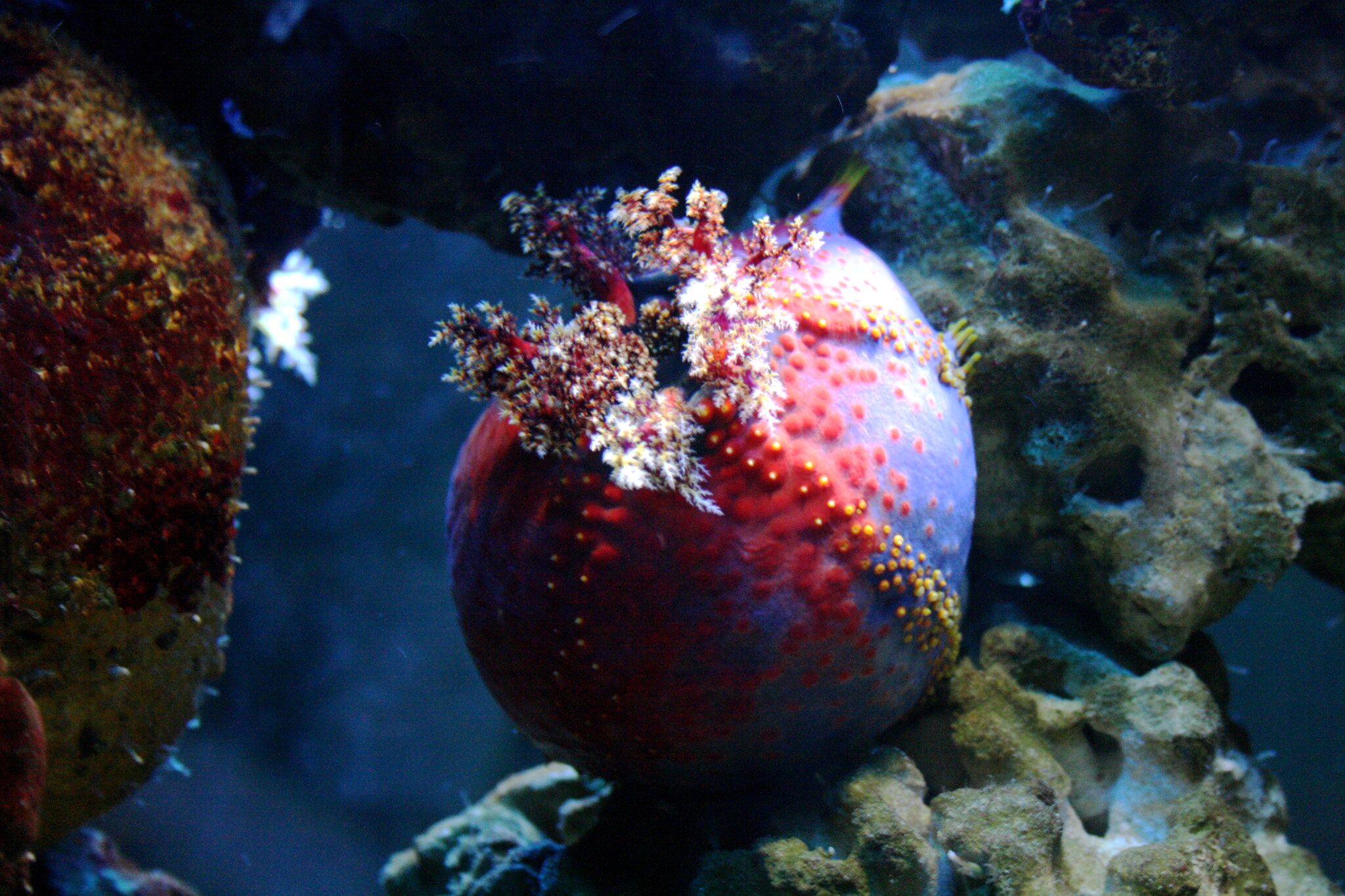When most hobbyists imagine sea cucumbers, or holothuroid species as they’ll be referred to later, we envision bottom-dwelling detritivores with little personalities whose slug-like bodies made their way into our tank simply to serve as valuable members of the clean-up-crew.
While the value of detritivore species does indeed make cucumbers valuable members for utilitarian purposes, there are, however, a large number of brightly colored species with lifestyles that vary greatly from those most common in the hobby.
These are the suspension-feeding cucumbers that many hobbyists find to be highly intriguing, as their uniquely charming method of food collection can be an interesting sight to behold. Instead of feeding on detritus or being buried in the sandbed, these species (such as the beloved “Sea Apple”), instead use tentacles for the collection of particles suspended in the water column.
Research has shown that at least some suspension-feeding holothuroid species are also highly efficient at absorbing organic matter such as that from fish food as well as fish feces, leading to a reduction in organic loading which is quite a valuable service provided by an already fascinating invertebrate (Nelson et al., 2012).
Not only do many such species tend to possess striking morphological characteristics and a unique lifestyle, but unlike detritivorous species they possess the ability to navigate upper areas of the tank as well, sticking to every surface imaginable as they inch their way over rockwork in search of the ideal flow for the deliverance of the suspended organic particles on which they feed.
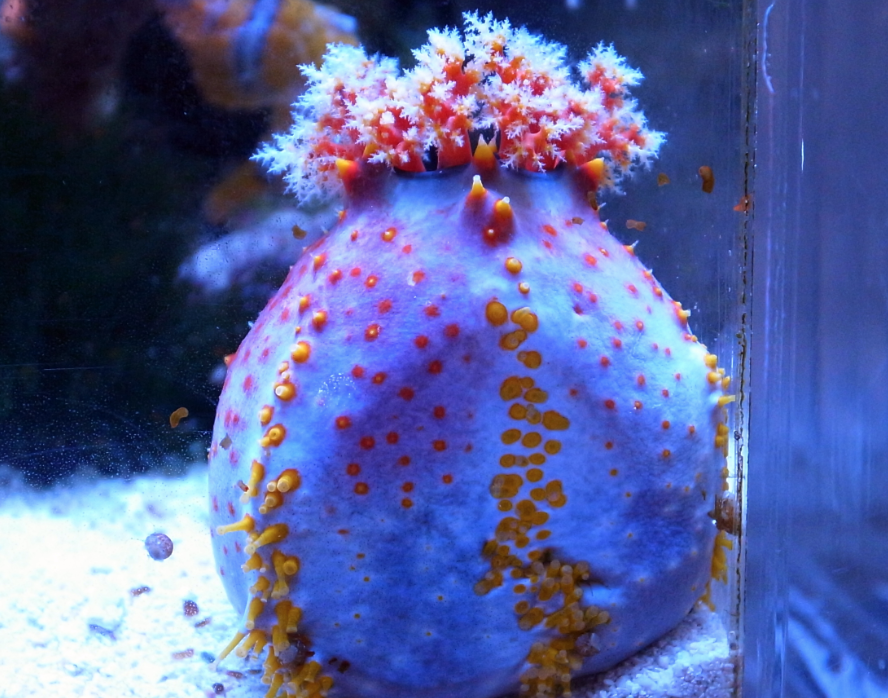
The Sea Apple, Pseudocolochirus violaceus
Among the most iconic and commonly available species reliant upon this feeding method is the previously mentioned Sea Apple (Pseudocolochirus violaceus). These curiously plump echinoderms commonly inspire a combination of admiration and fear in many hobbyists due to their lack of knowledge of the requirements for care.
Some have heard about a rare case involving the death of a specimen and the subsequent release of a toxin (holothurin) in addition to ammonia, a potent mixture more than capable of nuking a tank of considerable size.
While not quite as common in the hobby, there are many other species that share similar characteristics and requirements for aquarium maintenance, such as the “Pink Warty Sea Cucumber” (Cercodemas anceps) which is adorned with a psychedelic pink and orange body as seen below. Similar to the desire of a painter to be able to claim his art as one of a kind, we hobbyists enjoy a peculiar addition from time to time to add a unique touch to our artistic creations.
Suspension-feeding cucumbers are ideal candidates for the accomplishment of this goal and care is not quite as specialized or difficult as it might seem.
Biology
Holothuroid (sea cucumber) species such as Sea Apples and the Pink Warty Sea Cucumber are epibenthic echinoderms in nature, despite possessing the ability to climb most surfaces, including glass or acrylic aquarium panels when housed in captivity.
Although the diet of sea cucumber species can be highly variable, suspension-feeding species don’t fully burrow into the sand or even spend the majority of their time on the sandbed at all, unlike detritivores. Due to their dependency on currents to deliver suspended matter from the seawater for nutrition, they must allow their branched tentacles to be exposed higher in the water column to capture organic particulate matter.
However, the tentacles can be retracted into the body for protection, and when scraping the food entangled in the tentacles into the mouth where it enters the body cavity for digestion. Because the body of the cucumber remains partially exposed at all times and therefore vulnerable to predation, many species have adapted beautiful, vibrant colors and combinations of these colors to serve as a warning to predators.
In the event, that a predator is particularly unwavering in its attempt to consume the cucumber, the production of a toxic compound known as holothurin acts as a deterrent when released and is lethal to the majority of natural predators.
Nutritional Requirements
In their native environment, the suspended particles trapped by the exposed tentacles are primarily composed of a mixture of zooplankton, phytoplankton, and other organic matter.
It remains unknown if they will accept or are able to digest foods larger than that which they are naturally accustomed to. Therefore, a diet consisting of live phytoplankton should be added on a daily basis and products designed for corals that require small particulate matter can aid in ensuring nutritional requirements are met.
Suspension-feeding holothuroids eat continuously and, therefore, regular supplementation of live phytoplankton confers multiple benefits. Due to the inability of sea cucumbers to synthesize carotenoids, which are primarily obtained from the consumption of live phytoplankton in their natural habitat and play a vital role in many internal functions, health is likely to slowly decline if this or an adequate, alternative source is absent.
Other benefits of feeding live phytoplankton include decreased fouling of the water in smaller tanks and the possibility that reproduction will lead to the establishment of a small, but constant plankton population to serve as an ever-present source of food in larger systems.
Additional foods that may support health include fish eggs marketed and sold commercially such as Reef Nutrition’s “Real Oceanic Eggs” which are small enough to be accepted (diameter = 500-1500 µm) and other sources of zooplankton similar in size or smaller.
Foods high in lipids (such as fatty acids found in fish eggs) were shown to lead to increased growth rates in a study investigating the effects of various diets fed to a commercially farmed, but similar species (Cucumaria frondosa). However, it was concluded that the optimal diet should include live phytoplankton as well (Gianasi et al., 2016).

Aquarium Design, Care, and Behavior
Hobbyists wishing to house suspension feeders of any species must take certain aspects of the aquarium’s design and care into consideration. This holds particularly true when attempting to house species of sea cucumbers that feed on suspended particles because many aquariums have filter-feeding inhabitants but no suspension feeders, two feeding methods that differ slightly.
I have personally found the care of Sea Apples and the Pink Warty Sea Cucumber to be simple and straightforward with few aspects of the aquarium design and feeding regimen in need of being restructured.
While lighting is unimportant, proper flow and design of the reefscape are of paramount importance to the well-being of these species. Due to the delicate feeding tentacles, excessively strong flow leads to retraction of the tentacles into the body and could cause damage if the cucumber is unable to relocate itself to an area of weaker flow.
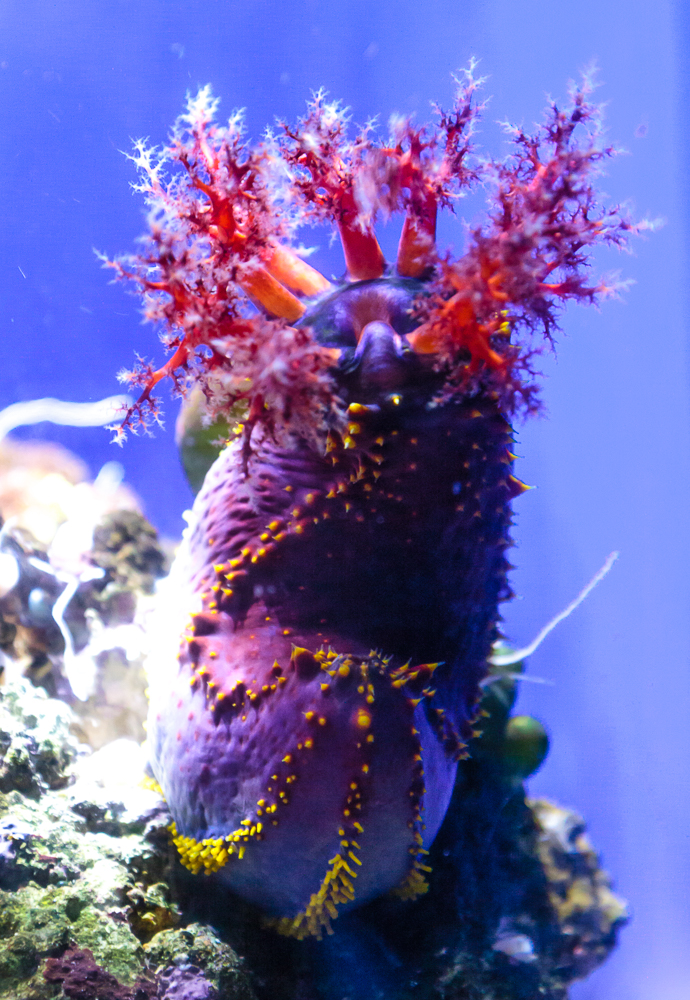
Moderate to slightly strong flow is preferred and the cucumber will locate a position deemed perfect by its own standards if allowed to roam freely.
After a slow acclimation, the cucumber will immediately begin to slink its way throughout the tank in search of the aforementioned ideal flow. Following the discovery of a suitable location to settle where food is frequently carried into its grasping tentacles, these species generally move very little unless flow is altered, food is absent, or it becomes the target of an aggressive fish or other tankmate that nip at the tentacles or body.
As a general rule of thumb, fish that are known to nip feather dusters or other worms should be housed separately as this can be a trigger for the release of the much-feared toxin, holothurin. Although it is possible to house more than one individual in the same aquarium, this reduces suspended food which could lead to malnutrition over time.
Signs of starvation or other causes of ill health include shrinking of the body and/or loss of tentacles. If these symptoms are observed, the cucumber should be removed immediately, relocated to a quarantine tank alone with adequate flow, and fed more frequently until recovery.
NOTE: It must be remembered that copper is HIGHLY toxic to the majority of invertebrates and cucumbers are no exception. If quarantined following purchase, copper-based medications of any type cannot be used under any circumstances even in trace concentrations.
The Hazards of Holothurin
Many hobbyists are wary of purchasing sea cucumbers of this type due to the size attained by certain species such as Sea Apples which are often found in local shops. This is primarily due to the concern that if death were to occur, the high concentration of ammonia released may lead to the mortality of many other inhabitants of the aquarium.
If the death of this or a similar species were to occur, there does, however, exist a far greater concern. As mentioned previously, the presence of the toxic saponin known as holothurin used to deter predators is released when the cucumber dies, is highly stressed, or, in some species, the toxins may be released from the skin when a threat is detected.
This could occur from a hobbyist attempting to handle and relocate the specimen due to it settling in an undesirable location. If holothurin is released, depending upon the concentration, mortality of both fish and invertebrates will soon occur due to its high potency.
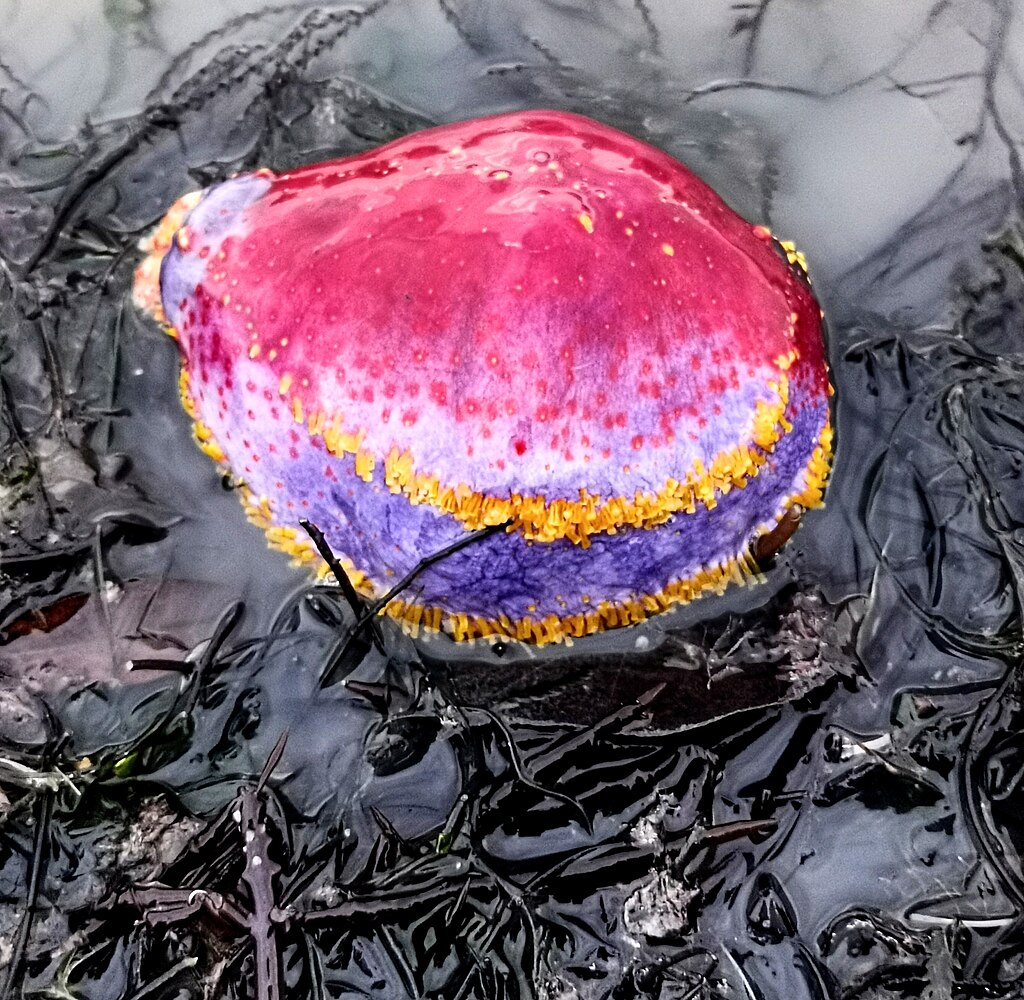
Although uncommon, the toxin can also be hazardous to humans, generally causing an onset of painful dermatitis and irritation of mucous membranes. If holothurin were to come into contact with the eyes, the resulting damage may be severe and even lead to blindness in serious cases (Ellis, 2021).
The good news, however, is that occurrences such as this are very rarely reported. Furthermore, the most common threat to hobbyists would be due to ill-advised handling of the cucumber without proper protection, which has been known to cause moderate to severe dermatitis or allergic reactions on rare occasions.
To put this risk into perspective, we hobbyists commonly house fish and invertebrates in possession of equally potent toxins which pose similar threats such as Palythoa and boxfish species, yet we very rarely experience the misfortunate event of a tank being nuked or fear for our own safety.
Instead, we tremendously enjoy the beauty of these creatures without a second thought about the hazards posed if their toxins were to be released. Using only common sense and the knowledge acquired here, reef-keepers needn’t worry endlessly about the potential hazards of these remarkable holothuroids.
Final Word
Despite the mysterious appearance and potential release of holothurin, these quirky echinoderms can make a fine addition to many hobbyists’ tanks. As invertebrates, neither overcrowding nor territoriality are prevalent concerns and their addition adds an alluring touch, surpassing that of most fish.
Below is a short list of suspension-feeding cucumbers available to hobbyists. While each species listed produces holothurin, they vary in physical aspects such as size and color. The dietary requirements of each are also highly similar, consisting primarily of phytoplankton and other organic particulate matter such as zooplankton and fish feces.
Pink Spiny Sea Cucumber, Pentacta anceps
This species can grow to 5 inches in the home aquarium and due to its smaller size can be housed in tanks of 20 gallons or more.
Sea Apple, Pseudocolochirus violaceus
Due to the ability to reach a size of approximately 7 inches in captivity with a very large gut, larger aquariums are highly recommended.
The Sea Apple (Pseudocolochirus violaceus) above pictured with feeding tentacles retracted is one of the most popular species available to hobbyists. Note the globular shape and circumference of the gut in comparison to length. Image: Malcolm Levison
Pink Warty Sea Cucumber, Cercodemas anceps
Unfortunately, this species is less commonly exported but is my personal favorite. They remain small and add an uncommon splash of pastel pink, orange, and yellow to an aquarium.
A vividly colored species, the “Pink Warty Sea Cucumber” (Cercodemas anceps) extends its tentacles in a similar manner as other species to collect suspended particles flowing through the water column. Image: Malcolm Levison
Yellow Knobby Sea Cucumber, Colochirus robustus
Reaching a size of only 3 inches, this species and the “Pink Warty Sea Cucumber” are the best suited of those listed here for small tanks. Their vibrant yellow bodies make them an eye-catching addition. Aquariums of 10 gallons or larger are adequate for their care.
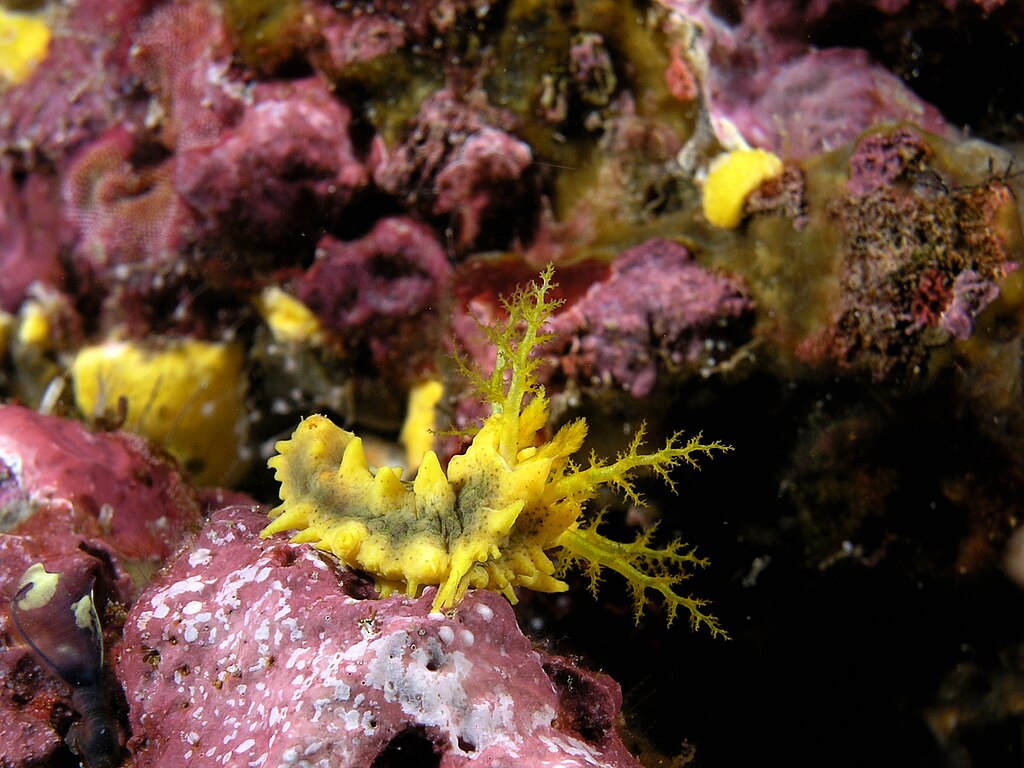
References
Ellis, C. (2021). Aquatic antagonists: Sea cucumbers (holothuroidea). Cutis, 108(2). https://doi.org/10.12788/cutis.0323
Gianasi, B. L., Parrish, C. C., Hamel, J.-F., & Mercier, A. (2016). Influence of diet on growth, reproduction and lipid and fatty acid composition in the sea cucumber, Cucumaria frondosa. Aquaculture Research, 48(7), 3413–3432. https://doi.org/10.1111/are.13168
Nelson, E. J., MacDonald, B. A., & Robinson, S. M. C. (2012). The absorption efficiency of the suspension-feeding sea cucumber, Cucumaria frondosa, and its potential as an extractive integrated multi-trophic aquaculture (IMTA) species. Aquaculture, 370–371, 19–25. https://doi.org/10.1016/j.aquaculture.2012.09.029
About the author

Malcolm Gray Levison is an avid diver, reef-keeping hobbyist, and dive photographer who takes great joy in sharing his experiences with others through his writing.
He also possesses a true passion for studying the biology and ecology of coral reefs and desires to contribute to the conservation of these fragile ecosystems.


